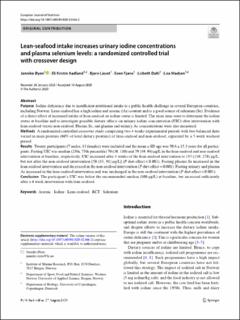| dc.contributor.author | Øyen, Jannike | |
| dc.contributor.author | Aadland, Eli Kristin | |
| dc.contributor.author | Liaset, Bjørn | |
| dc.contributor.author | Fjære, Even | |
| dc.contributor.author | Dahl, Lisbeth | |
| dc.contributor.author | Madsen, Lise | |
| dc.date.accessioned | 2020-10-23T08:56:56Z | |
| dc.date.available | 2020-10-23T08:56:56Z | |
| dc.date.created | 2020-08-31T14:54:06Z | |
| dc.date.issued | 2020 | |
| dc.identifier.citation | Øyen, J., Aadland, E. K., Liaset, B., Fjære, E., Dahl, L., & Madsen, L. (2020). Lean-seafood intake increases urinary iodine concentrations and plasma selenium levels: A randomized controlled trial with crossover design. European Journal of Nutrition. | en_US |
| dc.identifier.issn | 1436-6207 | |
| dc.identifier.uri | https://hdl.handle.net/11250/2684701 | |
| dc.description.abstract | Purpose
Iodine deficiency due to insufficient nutritional intake is a public health challenge in several European countries, including Norway. Lean-seafood has a high iodine and arsenic (As) content and is a good source of selenium (Se). Evidence of a direct effect of increased intake of lean-seafood on iodine status is limited. The main aims were to determine the iodine status at baseline and to investigate possible dietary effects on urinary iodine concentration (UIC) after intervention with lean-seafood versus non-seafood. Plasma Se, and plasma and urinary As concentrations were also measured.
Methods
A randomized controlled crossover study comprising two 4 weeks experimental periods with two balanced diets varied in main proteins (60% of total dietary proteins) of lean-seafood and non-seafood, separated by a 5 week washout period.
Results
Twenty participants (7 males, 13 females) were included and the mean ± SD age was 50.6 ± 15.3 years for all participants. Fasting UIC was median (25th, 75th percentile) 70 (38, 110) and 79 (49, 94) µg/L in the lean-seafood and non-seafood intervention at baseline, respectively. UIC increased after 4 weeks of the lean-seafood intervention to 135 (110, 278) µg/L, but not after the non-seafood intervention [58 (33, 91) µg/L] (P diet-effect < 0.001). Fasting plasma Se increased in the lean-seafood intervention and decreased in the non-seafood intervention (P diet-effect = 0.001). Fasting urinary and plasma As increased in the lean-seafood intervention and was unchanged in the non-seafood intervention (P diet-effect < 0.001).
Conclusion
The participant’s UIC was below the recommended median (100 µg/L) at baseline, but increased sufficiently after a 4 week intervention with lean-seafood. | en_US |
| dc.language.iso | eng | en_US |
| dc.publisher | Springer | en_US |
| dc.rights | Navngivelse 4.0 Internasjonal | * |
| dc.rights.uri | http://creativecommons.org/licenses/by/4.0/deed.no | * |
| dc.subject | arsenic | en_US |
| dc.subject | iodine | en_US |
| dc.subject | Lean-seafood | en_US |
| dc.subject | RCT | en_US |
| dc.subject | selenium | en_US |
| dc.title | Lean-seafood intake increases urinary iodine concentrations and plasma selenium levels: a randomized controlled trial with crossover design | en_US |
| dc.type | Peer reviewed | en_US |
| dc.type | Journal article | en_US |
| dc.description.version | publishedVersion | en_US |
| dc.rights.holder | © The Author(s) 2020 | en_US |
| dc.subject.nsi | VDP::Medisinske Fag: 700::Helsefag: 800::Ernæring: 811 | en_US |
| dc.source.journal | European Journal of Nutrition | en_US |
| dc.identifier.doi | 10.1007/s00394-020-02366-2 | |
| dc.identifier.cristin | 1826273 | |
| cristin.ispublished | true | |
| cristin.fulltext | original | |
| cristin.qualitycode | 1 | |

